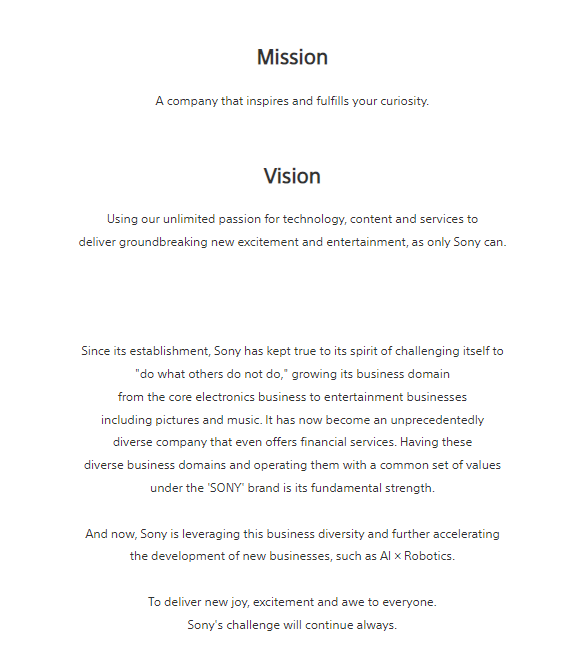Table of Contents
ToggleA Brief History of Sony
Sony Group Corporation, commonly known as Sony, is a Japanese multinational conglomerate corporation headquartered in Tokyo, Japan. It was founded on May 7, 1946, by Masaru Ibuka and Akio Morita. The company originally started as a small radio repair shop in a bomb-damaged building in Tokyo after World War II.
In 1955, Sony introduced Japan’s first transistor radio, which was a huge success and marked the beginning of the company’s global expansion. Sony continued to innovate and diversify its product line, introducing the first transistor television in 1960 and the world’s first all-transistor television set in 1965. In 1968, Sony launched the Trinitron color television, which became a global bestseller.
Throughout the 1970s and 1980s, Sony expanded into various consumer electronics markets, including the Walkman portable cassette player, the Betamax video recording format, and the PlayStation gaming console. In the 1990s, Sony entered the entertainment industry by acquiring Columbia Pictures Entertainment and CBS Records, becoming a major player in the music and film industries.
Sony continued to grow and diversify its business, venturing into areas such as semiconductors, financial services, and telecommunications. The company faced some challenges in the early 2000s, including the failure of the Betamax format and increased competition in the consumer electronics market. However, Sony successfully restructured its operations and continued to innovate with the launch of the PlayStation 3, Bravia LCD TVs, and the Blu-ray format.
In recent years, Sony has focused on expanding its presence in the gaming, entertainment, and imaging sectors. The company has also made strategic acquisitions and partnerships to strengthen its position in the streaming, music, and content creation markets.
Today, Sony Group Corporation is a leading global conglomerate with a diverse portfolio of businesses, including electronics, gaming, entertainment, and financial services. It continues to be a pioneer in technology and entertainment, with a strong global presence and a reputation for innovation and quality.
Who Owns Sony?
Sony Group Corporation is a publicly traded company, meaning it is owned by a multitude of shareholders who own shares of the company. The top 10 shareholders of Sony Group Corporation as of the latest available data are as follows:
1. The Vanguard Group, Inc.
2. BlackRock, Inc.
3. Capital Research & Management Co.
4. State Street Corporation
5. Norges Bank Investment Management
6. Japan Trustee Services Bank, Ltd.
7. MFS Investment Management
8. Mitsubishi UFJ Financial Group, Inc.
9. Sumitomo Mitsui Trust Asset Management Co., Ltd.
10. Northern Trust Corporation
These shareholders collectively own a significant portion of the company and have a say in its operations and decision-making through voting rights and other privileges associated with ownership of shares.
Sony Mission Statement

The mission of Sony Group Corporation is to be a company that inspires and fulfills customers’ curiosity. They strive to create technologies and products that excite and entertain customers, while also contributing to the well-being of society and the natural environment. Sony is committed to delivering innovative and high-quality products and services that enrich people’s lives and enhance their experiences. Their mission is to continue pushing the boundaries of creativity and technology to create a better future for all.
How Sony Makes Money?
Sony Group Corporation operates under a diversified business model that generates revenue through several streams. The company’s primary source of income comes from its electronics segment, which includes the production and sale of electronic devices such as televisions, cameras, and smartphones. Additionally, Sony generates revenue from its gaming division, which designs and sells PlayStation gaming consoles and related software. The company also has a thriving music and entertainment business, with revenue derived from the production and distribution of music and movies. Furthermore, Sony has a financial services division that offers insurance and banking products. Overall, Sony Group Corporation’s business model is built on a diverse range of products and services that cater to various consumer needs, allowing the company to generate revenue from multiple sources.
Sony Business Model Canvas
The Business Model Canvas is a strategic management tool that allows companies to visually map out and analyze their business model. It is made up of 9 key components that cover all aspects of a business, from customer segments to cost structure, and helps organizations to understand how they create, deliver, and capture value.
Customer Segments:
– Consumer Electronics: The primary customer segment for Sony Group Corporation includes consumers who are interested in purchasing electronics such as TVs, cameras, and headphones.
– Professional Solutions: Sony also targets B2B customers in the professional solutions segment, including businesses in the entertainment, gaming, and imaging industries.
Value Propositions:
– Innovative Technology: Sony’s value proposition lies in its ability to consistently deliver cutting-edge technology and innovative products to its customers.
– Quality and Brand Reputation: Sony’s strong brand reputation and commitment to quality are additional value propositions that attract customers.
Channels:
– Retail Partnerships: Sony sells its products through a network of retail partners, including electronics stores, department stores, and online retailers.
– Own Retail Stores: Sony also has its own retail stores and online platforms through which it directly sells its products to customers.
Customer Relationships:
– After-Sales Service: Sony focuses on building long-term relationships with its customers by providing after-sales services and support for its products.
– Community Engagement: Sony also engages with its customers through communities, forums, and social media to build a sense of belonging and loyalty.
Revenue Streams:
– Product Sales: The primary revenue stream for Sony comes from the sale of consumer electronics, professional solutions, and gaming products.
– Subscriptions and Services: Sony generates additional revenue through subscriptions to its gaming and entertainment platforms, as well as through service contracts for professional solutions.
Key Resources:
– Research and Development: Sony invests heavily in R&D to develop new technologies and products that set it apart from competitors.
– Manufacturing Facilities: Key resources also include the manufacturing facilities and supply chain that enable Sony to produce and distribute its products.
Key Activities:
– Product Development: Sony’s key activity is to continuously innovate and develop new products that meet the evolving needs of its customers.
– Marketing and Branding: Sony also invests in marketing and branding activities to promote its products and maintain brand relevance.
Key Partners:
– Component Suppliers: Sony relies on key partners, such as component suppliers, to ensure a steady supply of high-quality parts for its products.
– Retail Partners: Partnerships with retail outlets and online platforms are essential for Sony to reach its customer segments and generate sales.
Cost Structure:
– R&D Expenses: Sony incurs significant costs in research and development to maintain its position as an industry leader in technology and innovation.
– Manufacturing and Distribution: The cost structure also includes expenses related to manufacturing, shipping, and distributing products to customers.
Sony Competitor’s
Sony Group Corporation faces strong competition in the consumer electronics and entertainment industries. Its top five competitors include Samsung, Apple, Microsoft, LG, and Panasonic. These companies compete with Sony in areas such as smartphones, televisions, gaming consoles, and music and movie production. Sony must continually innovate and differentiate its products and services in order to maintain its competitive position in the market.
Sony SWOT Analysis
Strengths:
1. Strong brand recognition and reputation in the global market
2. Diversified product portfolio including consumer electronics, gaming, entertainment, and financial services
3. Robust research and development capabilities leading to innovative products
4. Strong global presence with a wide distribution network
5. Strong entertainment and music divisions
Weaknesses:
1. Reliance on a few key markets for a significant portion of revenue
2. Lack of focus on specific product categories leading to lack of competitive edge
3. High sensitivity to changes in consumer preferences and technological advancements
Opportunities:
1. Expansion into emerging markets such as India and China
2. Growing demand for gaming and entertainment content
3. Increasing adoption of digital products and services
4. Potential for strategic partnerships and collaborations in various industries
Threats:
1. Intense competition from both established and emerging companies
2. Rapid technological advancements leading to shorter product lifecycles
3. Economic and geopolitical uncertainties impacting global operations
4. Increasing regulatory scrutiny in various markets
Concluding Analysis
In conclusion, the business model of Sony Group Corporation reflects a strong focus on innovation, diversification, and customer-centric strategies that have allowed them to remain a key player in the global market. As an analyst, I am optimistic about the future of the business, particularly with their continued investment in cutting-edge technologies and expansion into new markets. I believe that Sony Group Corporation is well-positioned to adapt to changing consumer preferences and emerging industry trends, and will continue to thrive in the years to come. Their commitment to excellence and forward-thinking approach gives me confidence in their ability to maintain their competitive edge and drive sustainable growth in the future.
Additional Resources
To keep learning and advancing your career, we highly recommend these additional resources:
Business Model Canvas of The Top 1,000 Largest Companies by Market Cap in 2024
A List of 1000 Venture Capital Firms & Investors with LinkedIn Profiles
Peter Thiel and the 16 Unicorns: The Legacy of Thiel Fellowship












